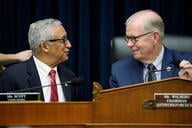You have /5 articles left.
Sign up for a free account or log in.

Financial aid administrators worry about the impact of federal policies on enrollment.
Photo illustration by Justin Morrison/Inside Higher Ed | deeepblue and klyaksun/iStock/Getty Images
The annual National Association of Student Financial Aid Administrators conference convened in Anaheim, Calif., this morning under a cloud of worry.
For student aid professionals in attendance and thousands more across the country, the past few months of federal funding cuts by the Trump administration have put serious stress on their offices. Now Congress is planning the most significant overhaul of student aid policy in decades.
Lawmakers’ proposed cuts to federal student aid programs—such as a $2,000 decrease in the maximum Pell Grant, caps on federal loans for graduate degrees and the elimination of college-access initiatives like TRIO—would put more onus on colleges to increase affordability. At the same time, universities must cope with the financial gut punch of losing billions of dollars in research funding and the looming threat of state budget cuts.
NASFAA president Melanie Storey said she’s had many conversations with financial aid professionals and enrollment leaders over the past month about the effects of federal higher ed funding cuts and policy shifts on financial aid. They’re all concerned about how the changes will affect students, she said; they just don’t know how worried to be yet.
“Financial aid budgets thrive on predictability,” she said. “Right now, that’s in short supply.”
But one thing seems fairly certain to Storey: Because of federal cuts, students “will be expected to pay more for college.”
Inside Higher Ed reached out to financial aid offices at nearly a dozen institutions, from private nonprofit colleges to public flagships. Officials said largely the same thing: that uncertainty reigns and they’ll have to wait and see how federal cuts and policy changes affect financial aid next year. They all said that preserving need-based student aid would be a priority in any budget restructuring or strategic cuts to come.
But two senior financial aid officials at large public research universities, both of whom requested anonymity to speak candidly without their institutions’ permission, said cuts to institutional grants and aid will be difficult to avoid.
One of the officials said more than next fall’s financial aid offers are in question. Aid packages that have already been sent to students or are currently being finalized are up in the air, they said, as Congress’s budget reconciliation bill nears a summer deadline.
That bill would slash federal loans for graduate students, student parents and more, and end unsubsidized loans, raising net costs and putting pressure on institutions to help students cover the difference—even as cuts to federal research grants and added costs hamper their ability to do so. It would also disqualify students who receive free tuition from receiving Pell Grants, which could make colleges less likely to give full rides to avoid missing out on a shrinking pot of federal aid.
“I don’t think schools are prepared to fill any gaps that the government takes away from us,” the anonymous financial aid official said. “Honestly, I think some vulnerable student populations are really going to suffer, or may not be able to attend at all.”
Aid Austerity
Some colleges that have recently expanded financial aid offerings are already considering walking them back. In Maine, a highly successful free community college program is on the chopping block after only three years as the State Legislature prepares for a lean fiscal 2026 budget. Higher ed advocates fear that lawmakers in many more states will explore reducing or discontinuing expanded state aid programs for similar reasons.
A proposed hike on the endowment tax from 1.4 percent to 8 percent would have a pronounced effect on wealthy private institutions and could undermine their ability to dole out institutional grants as generously as they have in the past. Anne Harris, the president of Grinnell College—one of the few dozen institutions with an endowment large enough to be hit with the full 8 percent rate—said that while Grinnell would do everything it can to abide by its no-loan promise, the new tax and other financial pressures would strain its aid budget.
Financial aid offices occupy a unique place in university budgets. They represent a major expenditure in the form of aid packages but also generate significant revenue by driving enrollment through affordability measures and carefully crafted tuition discounts.
Storey, who formerly oversaw policy implementation and oversight at the Office of Federal Student Aid, said that as colleges look to mitigate the effects of federal and state funding volatility, financial aid offices will likely play a key role. That won’t mean simply adjusting award packages, she said; it will also involve new enrollment-management strategies to boost tuition revenue. Officials at public universities may need to skew the ratio of in-state to out-of-state students, for instance, or private colleges might enroll more wealthy students. Some might attempt to recruit more international students—though the Trump administration is making that increasingly difficult.
Ken Ferreira, president of the Eastern Association of Student Financial Aid Administrators, which represents financial aid officials at colleges from D.C. to Maine, said his members know they’ll have to be part of their institutions’ strategic response to the new federal funding reality.
He described college affordability and student aid efforts as a “multipronged partnership” consisting of universities, philanthropic organizations, state policymakers and the federal government. If the Trump administration and congressional Republicans pass their proposed higher education budget cuts and expensive new policies, that partnership will crumble, he said, sending financial aid offices scrambling to compensate for lost funds—sometimes by making difficult decisions about student aid packages.
“The entire student aid community is wondering, what’s going to change and how quickly will we need to pivot?” he said. “We will have to figure out how to minimize the impact of that fractured partnership … but regardless, there will be students who have doors to degrees completely shut for them.”
Robert Massa, a longtime enrollment management and financial aid administrator at institutions including Dickinson College and Johns Hopkins University and co-founder of the consulting firm Enrollment Intelligence Now, has more faith in colleges’ commitment to preserving institutional aid.
That’s not just because it’s what’s best for students; institutional aid, Massa said, has become an essential recruitment tool for a sector that faces mounting enrollment challenges and ever-stiffer competition, especially among private, nonprofit colleges with low name recognition and high sticker prices.
“It’s something of a prisoner’s dilemma: Colleges aren’t going to cut need-based or merit aid unless everyone comes to the conclusion that they have to at the same time,” he said. “I don’t see a scenario where competing on price goes away.”
Phil Levine, an economist at Wellesley College who has studied financial aid for decades, said that competitive incentive won’t stop aid offers from declining.
“Net prices are going to rise,” he said. “The entire range of policies about to be implemented will have huge effects downmarket … it will be difficult for institutions to maintain what they’re currently doing.”
For students, that could mean a stark difference in aid packages between this fall and next. One anonymous senior financial aid administrator said students might have to take out private loans or find new sources of income to make up the difference. They fear many will decide it’s just not worth it.
“I worry about the incoming class,” they said. “They’re receiving packages based on this year’s aid availability, and next year it could be totally different.”





